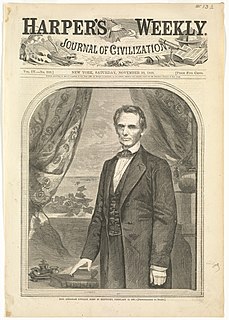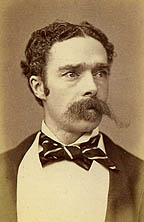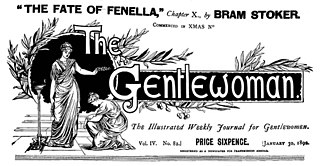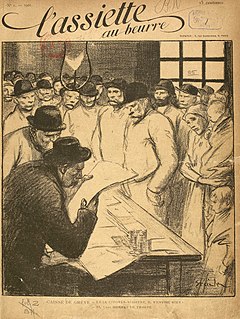
A magazine is a periodical publication which is printed in gloss-coated and matte paper or electronically published. Magazines are generally published on a regular schedule and contain a variety of content. They are generally financed by advertising, by a purchase price, by prepaid subscriptions, or a combination of the three.

Collier's was an American magazine, founded in 1888 by Peter Fenelon Collier. It was initially launched as Collier's Once a Week, then changed in 1895 to Collier's Weekly: An Illustrated Journal, and finally shortened in 1905 to Collier's: The National Weekly and eventually to simply Collier's. The magazine ceased publication with the issue dated for the week ending January 4, 1957, though a brief, failed attempt was made to revive the Collier's name with a new magazine in 2012.

Harper's Weekly, A Journal of Civilization was an American political magazine based in New York City. Published by Harper & Brothers from 1857 until 1916, it featured foreign and domestic news, fiction, essays on many subjects, and humor, alongside illustrations. It carried extensive coverage of the American Civil War, including many illustrations of events from the war. During its most influential period, it was the forum of the political cartoonist Thomas Nast.

The Illustrated London News appeared first on Saturday 14 May 1842, as the world's first illustrated weekly news magazine. Founded by Herbert Ingram, it appeared weekly until 1971, then less frequently thereafter, and ceased publication in 2003. The company continues today as Illustrated London News Ltd, a publishing, content, and digital agency in London, which holds the publication and business archives of the magazine.

The Penny Magazine was an illustrated British magazine aimed at the working class, published every Saturday from 31 March 1832 to 31 October 1845. Charles Knight created it for the Society for the Diffusion of Useful Knowledge in response to Chambers's Edinburgh Journal, which started two months earlier. Sold for only a penny and illustrated with wood-engravings, it was an expensive enterprise that could only be supported by very large circulation. Though initially very successful—with a circulation of 200,000 in the first year—it proved too dry and too Whiggish to appeal to the working-class audience it needed to be financially viable. Its competitor—which included a weekly short story—grew more slowly, but lasted much longer.
The Charles H. Kerr Publishing Company was established in Chicago, Illinois in 1886 as Charles H. Kerr & Co. by Charles Hope Kerr, originally to promote his Unitarian views. As Kerr's personal interests moved from religion to populism to Marxism and he became interested in the labor movement, the company's publications took a similar turn. During the 1920s Kerr ceded control of the firm to the Proletarian Party of America, which continued the imprint as its official publishing house throughout its four decades of organized existence.

The Graphic was a British weekly illustrated newspaper, first published on 4 December 1869 by William Luson Thomas's company Illustrated Newspapers Ltd. Thomas's brother Lewis Samuel Thomas was a co-founder. The premature death of the latter in 1872 "as one of the founders of this newspaper, [and who] took an active interest in its management" left a marked gap in the early history of the publication. It was set up as a rival to the popular Illustrated London News.
American News Company was a magazine, newspaper, book, and comic book distribution company founded in 1864 by Sinclair Tousey, which dominated the distribution market in the last quarter of the 19th century and the first half of the 20th century. The company's abrupt 1957 demise caused a huge shakeup in the publishing industry, forcing many magazine, comic book, and paperback publishers out of business.

Electrician and Mechanic was an American science and technology magazine published from 1890 to January 1914 when it merged with Modern Electrics to become Modern Electrics & Mechanics. In July 1914, incorporated with Popular Electricity and the World's Advance and the title became Popular Electricity and Modern Mechanics. The new publisher, Modern Publishing, began a series of magazine mergers and title changes so numerous that librarians began to complain. In October 1915 the title became Popular Science Monthly and the magazine is still published under that name today.

Frank Leslie's Illustrated Newspaper, later renamed Leslie's Weekly, was an American illustrated literary and news magazine founded in 1855 and published until 1922. It was one of several magazines started by publisher and illustrator Frank Leslie.

The Pall Mall Magazine was a monthly British literary magazine published between 1893 and 1914. Begun by William Waldorf Astor as an offshoot of The Pall Mall Gazette, the magazine included poetry, short stories, serialized fiction, and general commentaries, along with extensive artwork. It was notable in its time as the first British magazine to "publish illustrations in number and finish comparable to those of American periodicals of the same class" much of which was in the late Pre-Raphaelite style. It was often compared to the competing publication The Strand Magazine; many artists, such as illustrator Sidney Paget and author H. G. Wells, sold freelance work to both.

Matthew Somerville Morgan was an artist known mainly for his cartoons in various publications.

The Slave's Friend (1836-1838) was an anti-slavery magazine for children produced by the American Anti-Slavery Society (AASS). The short-lived magazine was the first abolitionist magazine targeted to a juvenile audience in the United States.

The Revolutionary Age was an American radical newspaper edited by Louis C. Fraina and published from November 1918 until August 1919. Originally the publication of Local Boston, Socialist Party, the paper evolved into the de facto national organ of the Left Wing Section of the Socialist Party which battled for control of the Socialist Party throughout the spring and summer of 1919. With the establishment of the Left Wing National Council in June 1919, the paper was moved from Boston to New York City gained status as the official voice of the nascent American communist movement. The publication was terminated in August 1919, replaced by the official organ of the new Communist Party of America, a weekly newspaper known as The Communist.

The Gentlewoman was a weekly illustrated paper for women founded in 1890 and published in London.

The Lady's Realm was a British women's magazine published from 1896 until 1914, possibly until 1915. It primarily targeted upper-class readers as well as an aspirational middle-class audience, featuring photographs, poems, fiction, and columns by popular authors such as Marie Corelli, Frances Hodgson Burnett, Jack London, and H.G. Wells. The London Season was regularly covered, with visuals of significant society figures and débutantes appearing. Fashion trends in Paris and London were frequently discussed as well, particularly by its fashion editor Marian Pritchard.

L'Assiette au Beurre was an illustrated French weekly satirical magazine with anarchist political leanings that was chiefly produced between 1901 and 1912. It was revived as a monthly for a time and ceased production in 1936.

A. L. Burt was a New York-based book publishing house from 1883 until 1937. It was founded by Albert Levi Burt, a forty year old from Massachusetts who had come to recognize the demand for inexpensive reference works while working as a traveling salesman. The company began by reprinting home reference works and reprints of popular and classic fiction, before expanding into the field of children's works, particularly series books.

The Missouri Centennial half dollar is a commemorative fifty-cent piece struck by the United States Bureau of the Mint in 1921. It was designed by Robert Ingersoll Aitken. The U.S. state of Missouri wanted a commemorative coin to mark its centennial that year. Legislation for such a coin passed through Congress without opposition, and was signed on March 4, 1921 by President Warren G. Harding on his inauguration day. The federal Commission of Fine Arts hired Aitken to design the coin, which depicted Daniel Boone on both sides. The reverse design, showing Boone with a Native American, was likely intended to symbolize the displacement of the Indians by white settlers.

















